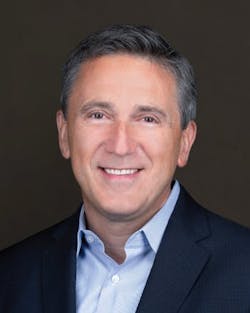Entegris Charts Its US Path as a Chip-Industry Supplier, Branching out from Asia
Advanced semiconductors are diva-like in their sensitivity to the tiniest disruptions. As the chips travel from one production step to the next, dust, metal and other environmental particulates measured in parts per quadrillion can degrade their performance, just as a light cough or touch of pollen in the air might throw off a singer’s aria.
But rather than lighter-than-usual applause, the cost is measured in millions of dollars. Losing one point of yield to contaminants can be a $500 million loss for a large chipmaker like TSMC or Intel.
For manufacturers of chips with very specialized uses—think a critical optical sensor in a car or a biosensor chip in a wearable medical device--“one of their major objectives is defect control,” said Bertrand Loy, CEO of Entegris, the world’s largest electronics materials company. “It’s a constant effort. They’re trying to remove large contaminants that can be the source of killer defects that impact their yields. And that can be a very expensive proposition.”
Losing one point of yield to contaminants can be a loss of $500 million a year for a company like TSMC or Intel, Loy said.
Entegris manufactures the specialized containers and filters, called FOUPS (Front-Opening-Unified Pods) that transport and protect the etched silicon wafers during the phases of production. “We are the lifeblood of those fabs,” Loy enthuses, referring to semiconductor production facilities. “And yet nobody knows about us.”
Nobody outside of the chips industry, perhaps. In June, it was announced that Massachusetts-headquartered Entegris, with 8,000 employees globally and $3.5 billion in net sales last year, will receive up to $75 million in U.S. CHIPS and Science Act funding, as well as a 25% capital investment federal tax credit, for the construction of a 100,000 square foot, two-phase manufacturing center in Colorado Springs, Colorado.
Currently, FOUPS are exclusively manufactured in Asia. Entegris is the largest producer of the containers, with manufacturing centered on its 195,000-square-foot facility in Kulim, Malaysia.
The endeavor won’t just help bring back semiconductor manufacturing to the U.S.; it will help bring it back to Colorado Springs, which was an innovation hub in the early days of semiconductors, before everything moved to Asia starting in the 1990s. There are other signs of life, too: recently, Microchip announced plants to triple its semiconductor production in Colorado Springs.
Construction is already well underway on the first phase of the plant, which will manufacture FOUPS and is expected to start production in early 2025. The second phase will manufacture advanced liquid filters and purifiers. Once fully running, the two facilities are expected to employ 600 people.
IndustryWeek spoke with Loy about the Colorado Springs facility and where it fits into rebuilding the U.S. semiconductor ecosystem in the United States.
IndustryWeek: Why are you building this new plant?
Loy: With much semiconductor manufacturing having moved to Asia over the last 30 years, a lot of our manufacturing investments have been closer to the fabs being built in Korea, Taiwan and elsewhere.
As the U.S. administration is trying to reassert semiconductor manufacturing, they have to take into account how to create the conditions for the right ecosystem to exist and operate smoothly. We're part of that effort. We are reshoring the manufacturing of critical components for semiconductor makers. That’s what this investment in Colorado is about.
Tell us more about FOUPs.
It’s essentially a highly engineered box. It’s a micro-environment in which the in-process wafers are transported throughout the fab [silicon wafer production]. From one process to the next, essentially that's going to be the home of the wafer for about two to three months. It’s critical to keep those wafers in a pristine environment.
We are the market leader in this particular product. You go to any fab in the world, you will see Entegris products. Today, that product is exclusively made in one of our factories in Malaysia. We're not closing the Malaysia site, but we will build a redundant manufacturing capability here in the U.S. to serve the U.S. and the European fabs that we expect to be built in the next decades.
What’s the construction timeline?
Everybody is trying to rush through. I mean, if you look at TSMC and some of the Intel investments [in U.S. production]; they're trying to go as fast as they can. So for us, what does that mean? It means we want all FOUPS to be available for our customers to evaluate and qualify by the middle of next year. It’s going to take them a few months to qualify our product, and we expect that some of their fabs will need those products later in 2025, early 2026.
Is that an aggressive timeline?
It’s a very tight schedule. … But this high-intensity pace is something that is unique to this industry. We always operate on a very tight timeframe, whether it is in the context of the new product development, or in the context of ramping up a new manufacturing site.
Here’s an example. During the pandemic, we developed a unique product that proved to be ideal for transporting COVID vaccines. Early days, everybody was panicking around the complexity of the cold storage requirements for global supply chains, how it would be done and whether it was even realistic to expect those vaccines to be available broadly. We had a concept that proved to be valuable. And we worked with Moderna, and Moderna said, ‘Well, it's great, but you don't have any manufacturing capability. We would need that in less than six months; it's impossible.’ And we said, ‘Well, we think we can do that. [Advanced materials containers] are what we do. And we do that really well.’ And that's what we did.
So every single vaccine from Moderna was, in fact, in an Entegris bag. It was a money-losing business for us. But we are proud that we contributed our piece to the [vaccination effort]. We do things that are very hard. And we do it well in a short amount of time.
Did you have to put together a new manufacturing line for that effort?
We put up three different manufacturing lines in three different locations to build enough redundancy, so it was a massive investment. Obviously, there are adjustments. It is essentially idle now, but we knew going in that it would necessarily not be a very financially rewarding initiative.
Will the Colorado plant be similar to what you have in Asia? Is there a template for these plants?
This industry is in a constant state of change. Every new facility is an opportunity for us to raise the bar in terms of process stability and capability. So we will raise the bar. Baseline will be the processes that exist in Malaysia today or elsewhere in the world. But we will improve on all of those processes so that the products that come out of Colorado will be the most advanced in their category.
What kind of volume will the plants be producing?
We’re not giving those numbers away, but this will be a multi-phase investment. So right now we're talking about the first two phases for a total of $600 million, but we bought a piece of land that could accommodate many more phases.
Why did you choose Colorado Springs?
We already have a small manufacturing site in Colorado Springs that’s been very successful. We started working with the state of Colorado, we got a lot of attention and it became apparent that this was the leading candidate.
For the site to be successful, we need to have access to the best possible talent. We already have a lot of partnerships and relationships with the local schools, the local universities [Pikes Peak State College is one]. We also have an incredible program, in connection with the Air Force Base in Colorado Springs, giving us access to a high-quality workforce coming from veterans and military families. [The company has a goal of hiring 50% of its new Colorado Springs workforce from veterans and military families through Hiring Our Heroes and other partners.] That's something that we wanted to continue to leverage.
The other side of that is, going to Arizona or upstate New York, we didn't want to compete for scarce talent with our customers. Everybody's building big fabs over there. Our brand is not as recognized as some of the large semiconductor manufacturers. And we didn't feel that we would be able to compete effectively for talent. Colorado has been voted one of the best cities to live in, in the U.S. It's also one of the fastest-growing cities in the country. So we think that this is going to be great for us in terms of access to talent.
That's one consideration. The other consideration is, we have committed to reducing our CO2 emissions by 42% by the end of the decade. To do that, we will need to reduce the energy we consume. In addition to that, by the end of the decade, we will need 50% of the energy we consume to come from renewable sources. Colorado has been one of the leading states in the country when it comes to building renewable energy infrastructure. [From 2020 to 2023, according to its corporate sustainability report, Entegris reduced its water usage 26%, its landfill waste 35% and its Scope 1 and 2 emissions 5%.]
Today, close to 40% of Colorado energy is coming from wind and solar. They are committed to continuing to invest in this particular infrastructure. We expect 80% of the energy used or consumed in this site to be from renewable sources.
Since we’re talking about energy, what about water? Semiconductor production requires a lot of water, and Colorado is one of the states that could be facing a water shortage in the coming decades.
We have a goal in our CSR program to reduce water consumption by 50%, when adjusted to revenue. And so we are building and investing in our own water recycling capacity. Eighty percent of the water that we will be using on the site will be water that we recycle, so that we don't draw too much on fresh water.
About the Author

Laura Putre
Senior Editor, IndustryWeek
As senior editor, Laura Putre works with IndustryWeek's editorial contributors and reports on leadership and the automotive industry as they relate to manufacturing. She joined IndustryWeek in 2015 as a staff writer covering workforce issues.
Prior to IndustryWeek, Laura reported on the healthcare industry and covered local news. She was the editor of the Chicago Journal and a staff writer for Cleveland Scene. Her national bylines include The Guardian, Slate, Pacific-Standard and The Root.
Laura was a National Press Foundation fellow in 2022.
Got a story idea? Reach out to Laura at [email protected]

